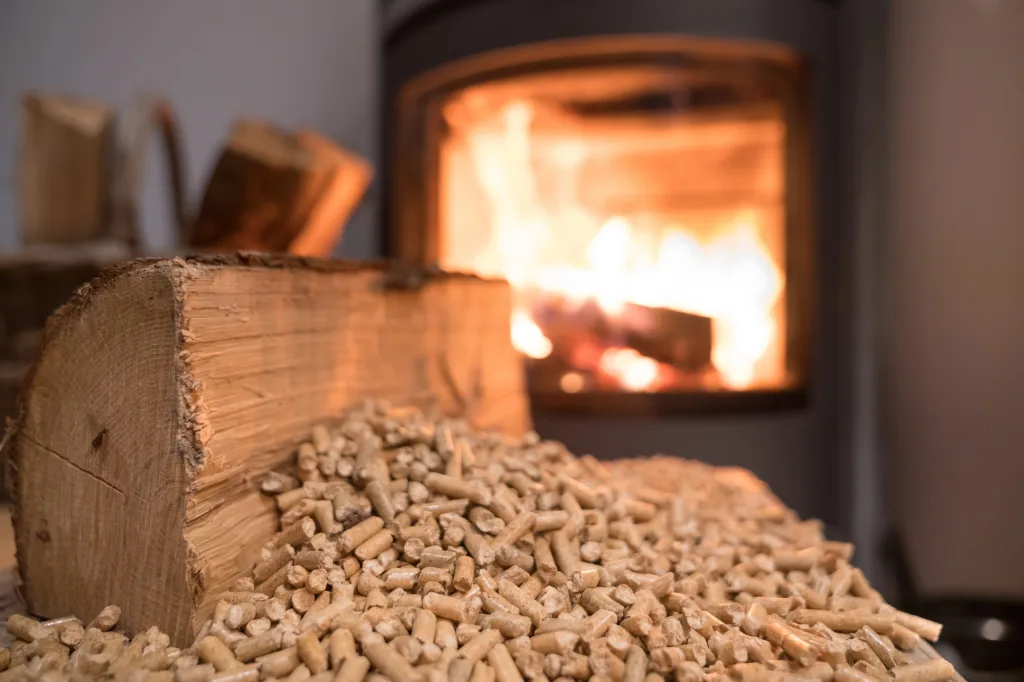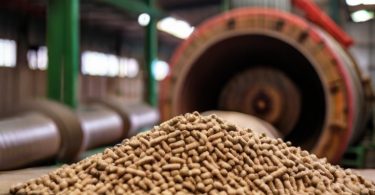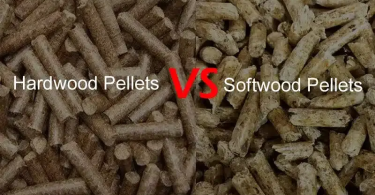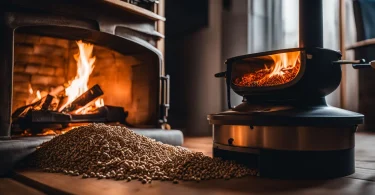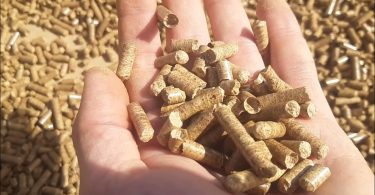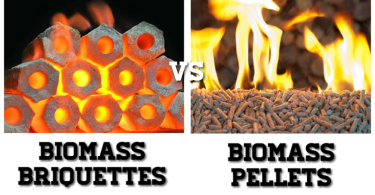There is a variety of wood fuels that you can use to heat your home during winter. When it comes to choosing the appropriate one, it all boils down to your preferences and the type of stove you have. Currently, the most popular wood fuel options are wood logs and wood pellets. Although they are similar in composition, there are many stark differences that you should understand before making your final choice.
In a Hurry ?
Bottom Line: Considering the comfort and the burning efficiency of wood pellets, it should be clear that this is a better fuel choice for heating your home in the winter time. When it comes to burning logs, to produce heat for your home, you should understand that this comes with more maintenance and more cleaning efforts needed on your side. For the above explained reasons, our vote goes to wood pellets as the better wood fuel to keep your house warm.
Wood Pellets for Heating
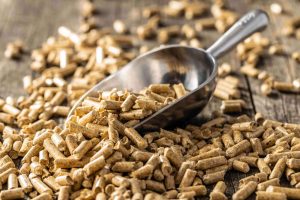
When it comes to wood pellets that are used for heating your home, it is useful to note that there are wood pellets that are used specifically for home heating, and those that are used for home cooking. Those that are used for home heating can come from either hardwood or softwood or from reclaimed materials.
In the first case, with wood pellets that are sourced from hardwood species, you will get a very durable product, that you can store for years and that has a long burn time. Softwood wood pellets burn much faster and also release more heat. The main difference here is that softwood pellets come from tree species that grow very fast and tend to store more carbon in their trunks.
When it comes to wood pellets coming from reclaimed materials, these are the most sustainable types of wood pellets there are. They use sawdust and chunks or wooden materials that remain from the wood processing industry or other connected industries. On top of this, it is also useful to note that agricultural pellets use waste left from agricultural processes. They’re all very sustainable and green solutions for eco-friendly homes and eco-friendly heating.
Wood pellets that are used for cooking can come from a variety of tree species and can only be made from virgin wood. This includes any type of wood that hasn’t been processed using any chemicals and does not come as a residue from another industry. Here are some commonly used types of version wood for cooking pellets:
- Apple,
- Mesquite,
- Cherry,
- Maple,
- Hickory, and
- Pecan.
Wood Logs for Heating
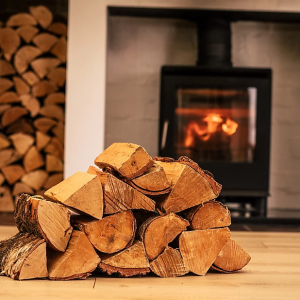
When it comes to wood logs that are traditionally used to heat spaces, they can be burned in any kind of wood stove. Pellets require a special pellet stove to be burned in. A wood log burns for a longer time and can potentially release more heat than pellets can. Similarly to pellets, wood logs can also be either hardwood or softwood logs.
Hardwood burns for a longer time and can release more heat overall, well softwood burns faster and can release more heat in a shorter period of time. For this reason, many homes use a mixture of the two types of wood.
The softwood is used as the starting fire in the morning, to heat up the space faster, and hardwood is used to keep the temperature at the comfortable level throughout the day and the evenings. Here are some commonly used types of wood for a home heating:
- Oak,
- Walnut,
- Maple,
- Birch,
- ash, and
- Elm.
Pellets vs. Wood Logs
Although these two types of wood fuels are very similar, it should be noted that they’re also differences between the two. To better understand the differences, and to help you choose the best wood fuel for your home, we will take a look at the energy that is stored in them, the environmental impact, the burning efficiency, the maintenance, and the sustainability and cost.
* Energy Stored
When it comes to the energy that is stored in a kilo of wood pellets and a kilo of wood logs, it is approximately the same. So, to better understand the energy that is stored in these two, we need to actually have a look at their moisture content. Woodlogs usually carry a lot of moisture in them, sometimes surpassing 20% of moisture content.
This means that out of all the energy that is stored within a long, only a portion can be used to heat your home, while the rest of the energy is used up to evaporate the water contained in the log and push this dance, heavy air out of your chimney. So, a single kilo of wood logs can produce anywhere between 1 and 4.5 kWh of energy. When it comes to wood pellets, you can expect around 4.85 kWh of energy to be released from each kilo of pellet. This is thanks to a low water content which is generally found in the range of between 5 and 10%.
* Environmental Impact
With lower moisture content, and special mechanisms that ensure higher combustion efficiency, burning pellets has a lower environmental impact in comparison to burning wood logs. This lower environmental impact can be seen in more CO2 being released and the expense of a significantly reduced emission of carbon monoxide, barely any PM particles being released, and less ash being produced. On top of this, it should also be mentioned that the higher burning efficiency with wood pellet stoves also contributes to a lower environmental impact.
* Burning Efficiency
In fact, most wood burning stoves are only around 40-80% efficient. When it comes to wood pellet burning stoves, their efficiency rates reach anywhere between 85-90%, with the most efficient models being around 91%. This burning efficiency means that more material undergoes the combustion process and fewer PM particles are released and less smoke is produced. On top of this, less ash is produced as well.
* Maintenance
Less ash means lower maintenance efforts for you. In fact, a wood burning stove can produce a lot of ash, so much that it needs to be emptied daily, depending on your heating needs. When it comes to wood pellet stoves, only 1-2% of the initial weight of the pellets can be found in the form of ash at the end of the burning process. In reality, pellet burning stoves only need to be cleaned once a week.
* Feedstock Material
This higher efficiency of the burning process and the lower environmental impact, as well as the lower maintenance all stem from high quality feedstock material that is used during the pellet production process. You may be wondering, how come the difference between these two fuels is still so big when they are both made out of wood.
Well, the answer lies in the fact that wood pellets are made from feedstock materials that come in the form of sawdust with a low moisture content of anywhere between 12 and 18% and are further dried. When it comes to wood logs, it is also useful to note that their larger volume makes them very difficult to dry. Some countries, such as Germany, do not allow woodlogs to be sold unless they have been previously dried for at least three years.
* Sustainability
Another factor that you should consider is the sustainability of the wood fuel that you use. When it comes to wood logs, they can come from responsibly managed forests or those that are not responsibly managed. In the first case, you will simply be burning the carbon that the trees have already captured from the atmosphere of, which makes wood logs a sustainable source of energy.
The same can be said for wood pellets, with an added benefit that the burning of wood pellets coming from waste from other Industries, significantly reduces the amount of methane, a powerful GHG gas that would otherwise be released into the atmosphere once the materials have been deposited into landfills.
* Cost
The cost of these two fuels is approximately the same, with a price sometimes being higher for wood pellets. However, before making judgments and going for the cheaper fuel, you should understand that the approximate price actually relates to the kWhs of energy that is released during the combustion process. When we compare these two, it is clear that a singular kWh of heat will cost you approximately the same. With this in mind, you should consider some added benefits of wood pellets and we suggest that you vote in their favor.
Wood Pellets Pros and Cons
Wood pellets have a lot of pros to list. Among the biggest ones is the very comfort that comes with using this type of wood fuel to heat your home. With a good wood pellet stove, you only need to refill the storage chamber once a day, and you only need to empty the ashtray once a week. Their high availability and the relatively low price are also some of the pros of using wood pellets. When it comes to the costs, their price is very volatile, and we can see that some political events can make their price skyrocket.
Burning Logs Pros and Cons
When it comes to burning logs, one of the biggest pros is the beauty of a wood log on fire. On top of this, a wood stove can also be used for cooking while heating your space. The traditional atmosphere is something that many enjoy. Among the biggest cons of burning logs is their lower combustion efficiency, more ash being produced, and a higher need for maintenance.
Final Considerations
Considering the comfort and the burning efficiency of wood pellets, it should be clear that this is a better fuel choice for heating your home in the winter time. When it comes to burning logs, to produce heat for your home, you should understand that this comes with more maintenance and more cleaning efforts needed on your side. For the above explained reasons, our vote goes to wood pellets as the better wood fuel to keep your house warm.

